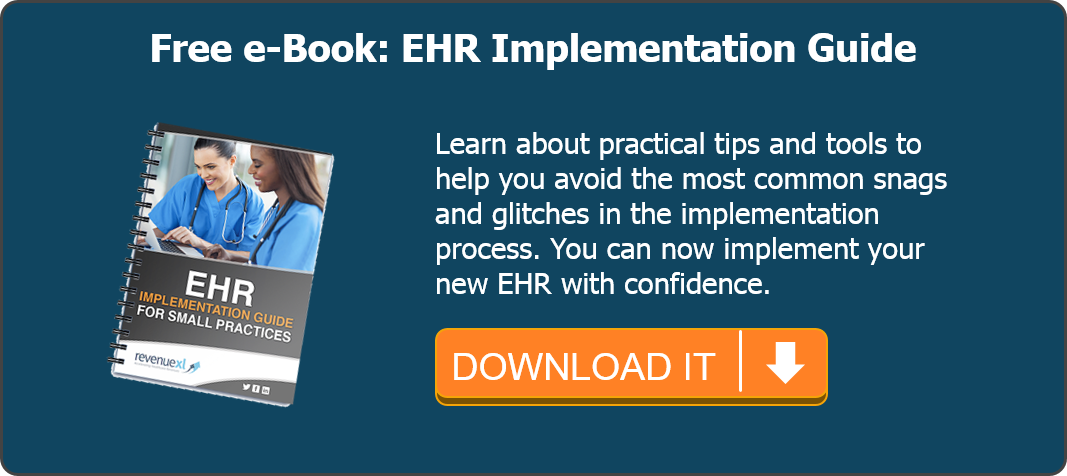EHR Implementation - Real Life Case Studies for Success
Implementing electronic health records, or making upgrades to existing systems, presents challenges for any type or sized medical practice. Luckily, a number of organizations have made the switch to electronic medical records in the past decade, which means your office can build upon lessons learned by others.

1. Efficiency should be a concern prior to software selection.
Documentation from Dr. Armand Gonzalez, who runs a solo pediatric practice in Illinois, indicates that efficiency should be a major concern for offices. According to Dr. Gonzalez, a lesson learned during his implementation is that software must integrate well with the practice and be user-friendly, or time-saving benefits of EHR are lost. Even before the implementation, staff at the pediatric practice thoroughly reviewed software options, asking questions about customization, security, and vendor support.
for offices. According to Dr. Gonzalez, a lesson learned during his implementation is that software must integrate well with the practice and be user-friendly, or time-saving benefits of EHR are lost. Even before the implementation, staff at the pediatric practice thoroughly reviewed software options, asking questions about customization, security, and vendor support.
Understand how individuals in your practice will access EHR software; options include desktop computers, laptops, and portable devices such as the iPad. Create a list of efficiency desires and other requirements before shopping software options so you have a checklist by which to rate each solution.
2. The process should be transparent.
Implementations across three critical access hospitals in North Dakota made it obvious that transparency was an important part of any EHR process. Change of any kind can breed fear or stress in staff, so a clear explanation of the reasons and goals behind a switch to EHR is important. Helping staff understand how electronic records fit into organizational goals and what benefits are expected builds increased internal support for the implementation, which usually leads to a smoother, faster process.
Consider including staff from all areas of the practice in brainstorming sessions, vendor reviews, planning, and testing. Everyone has something valuable to add, and you'll end up with a better result if you ensure clinical, administrative, and technical staff are all represented.
3. EHR implementations need a champion.
 The Chief Information Officer of Community Health Network in West Virginia published lessons learned from implementations in his organization. One of the first things he notes is that an EHR implementation should never move forward without an internal champion. The champion is the senior management or decision-making individual who has the power to push a project forward when it comes to resources. That person must be onboard with the project and understand the many benefits of EHR so they can see the ROI associated with expenditures.
The Chief Information Officer of Community Health Network in West Virginia published lessons learned from implementations in his organization. One of the first things he notes is that an EHR implementation should never move forward without an internal champion. The champion is the senior management or decision-making individual who has the power to push a project forward when it comes to resources. That person must be onboard with the project and understand the many benefits of EHR so they can see the ROI associated with expenditures.
4. Testing is crucial to success.
Whether you're using local servers or opted for web-based EHR solutions, testing is essential during implementation. Most vendors provide support during testing processes, especially with it comes to connectivity and technical testing. Depending on the size of your organization, internal IT staff may be required to test integration of the new vendor component with existing systems.
Regardless of size and scope, user testing usually falls on provider staff. Before a final implementation sign off, make sure all functionality is working. During the planning and implementation phases, create checklists of all user functionality, from clinician notation to claims billing. During testing phases, put various tasks through the entire checklist, having staff sign off at each point that the process is operating as expected.
5. Comprehensive training is essential.
Almost every lessons-learned document reviewed mentions the importance of training in an EHR implementation. Staff at the North Dakota  hospitals reported that EHR training could have been more comprehensive and noted the need for trainers to have a variable healthcare background. One thing that has worked for a number of offices is choosing individuals from each area to train on the new system; those individuals then bring comprehensive and area-based training back to staff in each department.
hospitals reported that EHR training could have been more comprehensive and noted the need for trainers to have a variable healthcare background. One thing that has worked for a number of offices is choosing individuals from each area to train on the new system; those individuals then bring comprehensive and area-based training back to staff in each department.
We can help alleviate your EHR implementation worries with software designed especially for small or medium-sized practices in a number of niches. Contact Revenue XL to find out more today.








